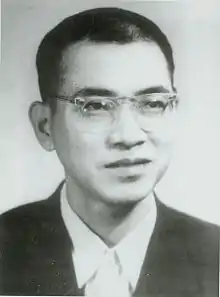Chen Jingrun | |||||||||||||||
|---|---|---|---|---|---|---|---|---|---|---|---|---|---|---|---|
 | |||||||||||||||
| Born | 22 May 1933 | ||||||||||||||
| Died | 19 March 1996 (aged 62) Beijing, China | ||||||||||||||
| Alma mater | Chinese Academy of Sciences Xiamen University | ||||||||||||||
| Known for | Chen's theorem, Chen prime | ||||||||||||||
| Scientific career | |||||||||||||||
| Fields | Mathematics | ||||||||||||||
| Doctoral advisor | Hua Luogeng | ||||||||||||||
| Chinese name | |||||||||||||||
| Traditional Chinese | 陳景潤 | ||||||||||||||
| Simplified Chinese | 陈景润 | ||||||||||||||
| |||||||||||||||
Chen Jingrun (Chinese: 陳景潤; 22 May 1933 – 19 March 1996), also known as Jing-Run Chen, was a Chinese mathematician who made significant contributions to number theory, including Chen's theorem and the Chen prime.
Life and career
Chen was the third son in a large family from Fuzhou, Fujian, China. His father was a postal worker. Chen Jingrun graduated from the Mathematics Department of Xiamen University in 1953. His advisor at the Chinese Academy of Sciences was Hua Luogeng.
His work on the twin prime conjecture, Waring's problem, Goldbach's conjecture and Legendre's conjecture led to progress in analytic number theory. In a 1966 paper he proved what is now called Chen's theorem: every sufficiently large even number can be written as the sum of a prime and a semiprime (the product of two primes) – e.g., 100 = 23 + 7·11.[1] Despite being persecuted during the Cultural Revolution, he expanded his proof in the 1970s.[2]
After the end of the Cultural Revolution, Xu Chi wrote a biography of Chen entitled Goldbach's Conjecture (哥德巴赫猜想). First published in People's Literature in January 1978, it was reprinted on the People's Daily a month later and became a national sensation. Chen became a household name in China and received a sackful of love letters from all over the country within two months.[3]
Chen died of complications of pneumonia on March 19, 1996, at the age of 63 years.[4]
Legacy

The asteroid 7681 Chenjingrun, discovered in 1996, was named after him.[1]
In 1999, China issued an 80-cent postage stamp, titled The Best Result of Goldbach Conjecture, with a silhouette of Chen and the inequality:[1]
Several statues in China have been built in memory of Chen. At Xiamen University, the names of Chen and four other mathematicians — Peter Gustav Lejeune Dirichlet, Matti Jutila, Yuri Linnik, and Pan Chengdong — are inscribed in the marble slab behind Chen's statue (see image).
Works
- J.-R. Chen, On the representation of a large even integer as the sum of a prime and a product of at most two primes, Sci. Sinica 16 (1973), 157–176.
- Chen, J.R, "On the representation of a large even integer as the sum of a prime and the product of at most two primes". [Chinese] J. Kexue Tongbao 17 (1966), 385–386.
- "Fundamental Number Theory"
References
- 1 2 3 Song, Yuwu (2014). Biographical Dictionary of the People's Republic of China. McFarland. p. 35. ISBN 978-1-4766-0298-1.
- ↑ Shi Xingze 石兴泽 (18 December 2017). "徐迟报告文学的突破、经验及警示意义" (in Chinese). China Writers' Association. Archived from the original on 26 October 2019. Retrieved 4 October 2019.
- ↑ Zhang Shouren 张守仁 (December 2016). "揭开诗人徐迟跳楼之谜" (in Chinese). Chinese University of Hong Kong. Archived from the original on 7 November 2020. Retrieved 4 October 2019.
- ↑ Lei, Ting; Belykh, Evgenii; Dru, Alexander B.; Yagmurlu, Kaan; Elhadi, Ali M.; Nakaji, Peter; Preul, Mark C. (2016). "Chen Jingrun, China's famous mathematician: Devastated by brain injuries on the doorstep to solving a fundamental mathematical puzzle". Neurosurgical Focus. 41 (1): E11. doi:10.3171/2016.2.FOCUS1595. PMID 27364253.
External links
- Chen Jingrun at the Mathematics Genealogy Project
- Chen's home page(in Chinese) at the Chinese Institute of Mathematics.